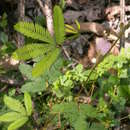en
names in breadcrumbs


Mimosa is a genus of about 590 species of herbs and shrubs, in the mimosoid clade of the legume family Fabaceae.[1] The generic name is derived from the Greek word μῖμος (mimos), an "actor" or "mime", and the feminine suffix -osa, "resembling", suggesting its 'sensitive leaves' which seem to 'mimic conscious life'.[2][3]
Two species in the genus are especially notable. One is Mimosa pudica, commonly known as touch-me-not, which folds its leaves when touched or exposed to heat. It is native to southern Central and South America but is widely cultivated elsewhere for its curiosity value, both as a houseplant in temperate areas, and outdoors in the tropics. Outdoor cultivation has led to weedy invasion in some areas, notably Hawaii. The other is Mimosa tenuiflora, which is best known for its use in shamanic ayahuasca brews due to the psychedelic drug dimethyltryptamine found in its root bark.
The taxonomy of the genus Mimosa has gone through several periods of splitting and lumping, ultimately accumulating over 3,000 names, many of which have either been synonymized under other species or transferred to other genera. In part due to these changing circumscriptions, the name "Mimosa" has also been applied to several other related species with similar pinnate or bipinnate leaves, but are now classified in other genera. The most common examples of this are Albizia julibrissin (Persian silk tree) and Acacia dealbata (wattle).
Members of this genus are among the few plants capable of rapid movement; examples outside of Mimosa include the telegraph plant, Aldrovanda, some species of Drosera and the Venus flytrap. The leaves of the Mimosa pudica close quickly when touched. Some mimosas raise their leaves in the day and lower them at night, and experiments done by Jean-Jacques d'Ortous de Mairan on mimosas in 1729 provided the first evidence of biological clocks.[4]
Mimosa can be distinguished from the large related genera, Acacia and Albizia, since its flowers have ten or fewer stamens. Botanically, what appears to be a single globular flower is actually a cluster of many individual ones. Mimosas contain some level of heptanoic acid.
There are about 590 species including:[1]
Mimosa is a genus of about 590 species of herbs and shrubs, in the mimosoid clade of the legume family Fabaceae. The generic name is derived from the Greek word μῖμος (mimos), an "actor" or "mime", and the feminine suffix -osa, "resembling", suggesting its 'sensitive leaves' which seem to 'mimic conscious life'.
Two species in the genus are especially notable. One is Mimosa pudica, commonly known as touch-me-not, which folds its leaves when touched or exposed to heat. It is native to southern Central and South America but is widely cultivated elsewhere for its curiosity value, both as a houseplant in temperate areas, and outdoors in the tropics. Outdoor cultivation has led to weedy invasion in some areas, notably Hawaii. The other is Mimosa tenuiflora, which is best known for its use in shamanic ayahuasca brews due to the psychedelic drug dimethyltryptamine found in its root bark.